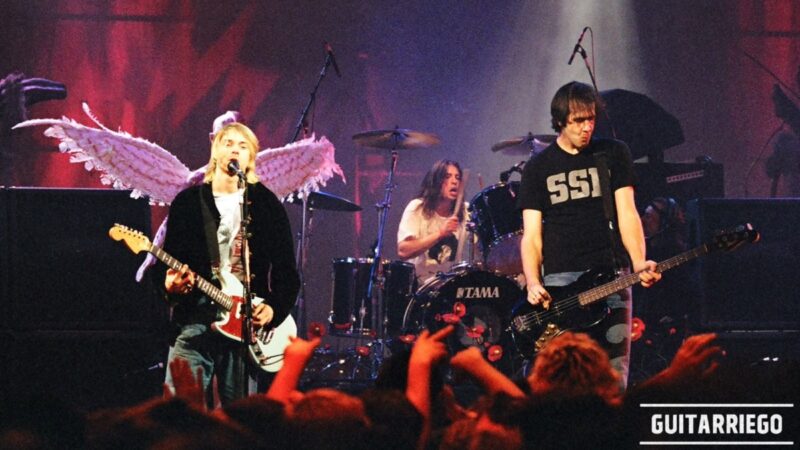F Chord on Guitar: Easy Way, simplified Chord with and without Barre
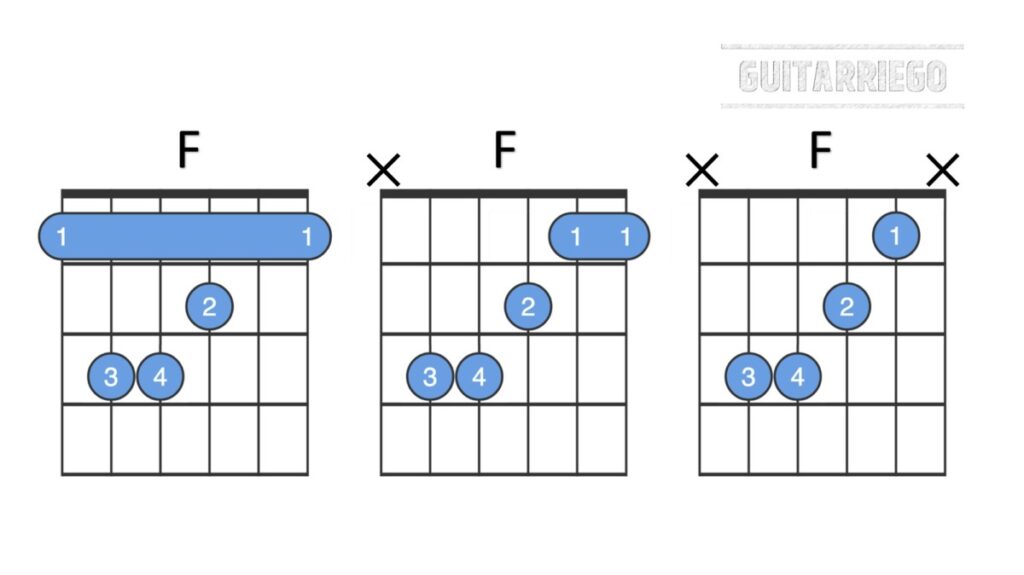
The F chord on the guitar is the first great difficulty that every beginner guitarist faces, with our guide we will teach you an easy way to play it without barre and an intermediate one so that you can later master the barre.
Difficulty in the F chord
Without a doubt, the F chord is one of the greatest challenges a beginning guitarist encounters in their first months of study. One of the main reasons is not the difficulty of the chord itself, which by the way, does exist. The real reason in our opinion is that you try to learn in a very direct way, without first training your hand correctly. It’s like pretending to master step 3 of a learning process without first mastering steps 1 and 2. So here are the 3 steps to mastering the full barre F chord.
Steps to Mastering the Full Barre F Chord:
- Learn the open F chord, which we here call the Easy F chord.
- Master the intermediate F chord, which is the exact point between the Easy Chord and the Full F chord.
- Build the F Chord with a full barre.
We recommend that you already have a good command of the C chord when you start with step 1.
You will find other methodologies to learn the F chord, which are focused on chord ease. However, some of these methods do not focus on the ultimate goal of mastering the Full Barre F chord with barre. Thus, our methodology from the beginning places all the fingers in the same position of the entire chord. While others, they move their fingers throughout their learning, which we do not recommend. What seems easier, they will go a long way in mastering the full F chord.
Here, the first step is based on mastering the position of fingers 2, 3 and 4. The second, to master the position of the hand and the thumb to be able to make the complete barre. Finally, in the third step, the two previous steps are combined to master the full F chord.
Learn different ways to play the F major chord on the guitar
Many times not mastering the F chord prevents you from playing amazing songs on the guitar. In fact, many of the most popular songs to play on the guitar are on the C Key that almost always uses the F chord. But don’t worry, there are several ways to play the F chord, and they are easy. Here we will teach you an easy way to play the F chord with your guitar without barre. In addition, we will also show you an intermediate chord that will be the perfect intermediate step to later master the Full Barre F chord on guitar. Best of all, the three versions of the F chords that we’ll teach you sound great on guitar.
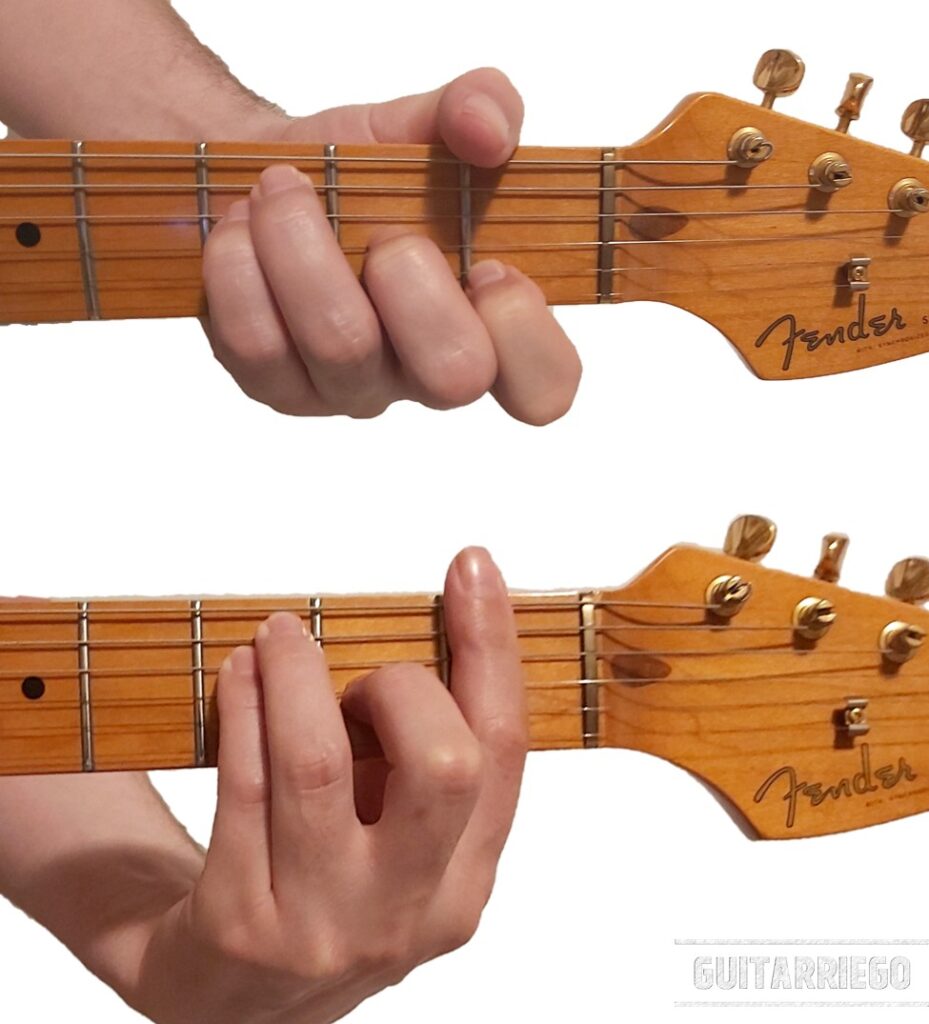
A path to complete mastery of the full barre F chord
There is a simple version of this important chord. The first F chord that we will see does not require barre, that is, it is an open chord, and it also sounds excellent. Thus, we will call the Open F chord, or if you prefer, the Easy F chord for guitar. If you already have mastered the C major chord, you already have much of the guitar and of your hand mastery that you need to play the simple F chord. The best part is that this chord will be the first step towards mastering the full F chord, so don’t think you’re doing the wrong thing. On the contrary, you are taking a step by step towards learning the F chord with full barre.
Does the easy F major chord sound good on guitar?
Surely the first thing you’ll think is that this isn’t the full F-bar chord, so it won’t sound as good. But you will be surprised how good it sounds, that is because in the Open F chord there are the three notes that make up the chord: F, A and C. Also, the 4 note positions you play are also part of the entire F chord with a full barre. Sure, it will sound different, but it will sound great. In fact, when you’re strumming the chords, you probably won’t even notice the difference.
The Open F chord is easier to play compared to a full barre chord, but it is also a different voice from the F chord. It is quite common for songwriters to use different chord voices in songs. This chord sounds more focused than the full F chord, it is ideal to combine with C and A minor chords.
Some previous concepts that are important to remember
The symbol “F”, or F chord is a shortened way of writing the F major chord. Thus, although we sometimes call it F major, when it only says F, it is understood to be a F major.
The F major is a simple major chord, also known as a major triad, the F major chord consists of three notes: the note F (degree I), the note A (degree III) and the note C (degree V). If we added the VII degree that would be the Eb (minor 7th) or E (major 7th), it would become a seventh chord: F7 or Fmaj7, but this would be another lesson.
Easy F Chord on Guitar
To put together the open and easy F major chord on the guitar, we won’t be playing the 1st and 6th strings. In this way we will only play strings 2, 3, 4 and 5 as shown in the following graph:
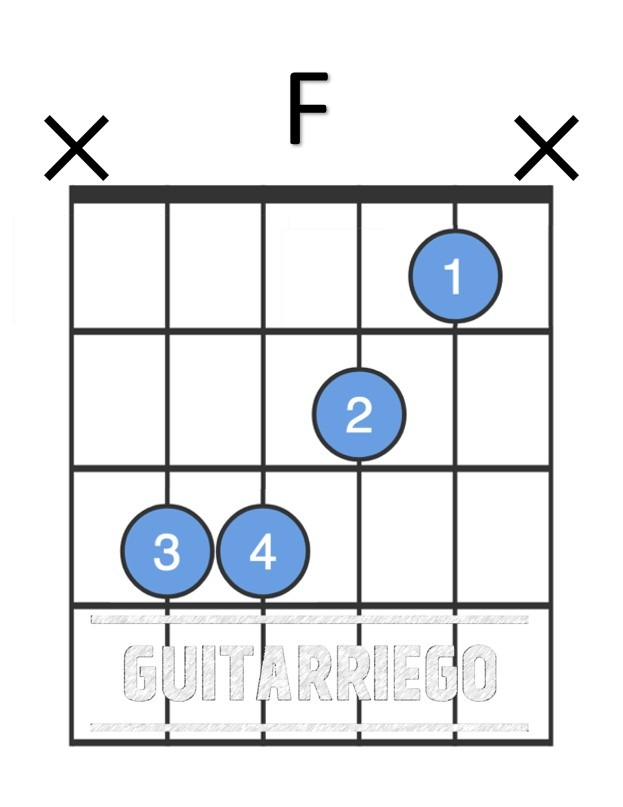
How to play the F chord on the guitar in an easy way?
The Easy F chord begins with the index finger on the first fret of the second string. Next, use your middle finger on the second fret of the third string. Your ring and little fingers will play the third fret on the fifth and fourth strings respectively. For this version of the F major chord, you will not be playing the high and low E strings.
Now, you know how to play the F chord on your guitar in an easy way. So, let’s work on the chord changes. Knowing the chord doesn’t help unless you can play it softly without thinking about it. So here is an excellent way to practice this, since:
- Use a chord that is used very often with F. You will practice a very common movement.
- Use the Common Chord Fingers method or just Similar Chords.
Steps to master the easy F chord on guitar:
- First, do the standard C major open chord. Then, you only need to do two movements to get to the easy F chord: Move your middle finger from the fourth to the third string, always on the second fret. Then add the pinky on the fourth string, third fret. Thus, you already have the easy open F chord assembled.
Note: Always keep your index and ring fingers in the same place, both when playing C and when changing to F. You should not lift them, they serve as a reference and reduce your effort with each chord change. So these are what we call common chord fingers. - Switch between the two chords several times, first without strumming to feel the movement. This helps with muscle memory in your hand. Then strum to ensure that your fingers are pressing correctly on each of the strings.
Note: To help you stay in tempo, use a slow speed metronome. You can use our free Online Metronome. Practice until you can change in time without stopping or slowing down. As you begin to master the open F chord and its changes to the C chord, increase the speed of the metronome a little, 5 bpm, to increase the speed. - Then, practice combining it with other chords, such as G, A minor, D minor, E minor, etc.
By practicing this for a few minutes a day, you will quickly master the simple F chord.
Advantages of learning the open F chord
Once you’ve mastered the open or easy F chord, you can play tons of songs on the guitar. In addition, you will already know how to place fingers 3, 4 and 5 in the same position as they go in the complete F chord with barre. Next, we suggest that you continue with the chord that we call “intermediate” F Chord. We call it that way, because it is the halfway point between the Easy Open F chord and the full barre F chord. This chord is the preparation to be able to dominate the barre chord on the guitar.
Intermediate F Chord with partial barre
The intermediate F chord is the step prior to mastering the full barre F chord. If you have already mastered the open F chord, which we here call the easy F chord, it is very easy to move on to the intermediate chord. With a slight change in the position of the index and thumb fingers, you go from the simple F chord to the intermediate one.
The intermediate F chord consists of making a short barre on strings 1 and 2 with your index finger. So, with a slight change in hand position, you have mastered the intermediate F chord with a partial barre.
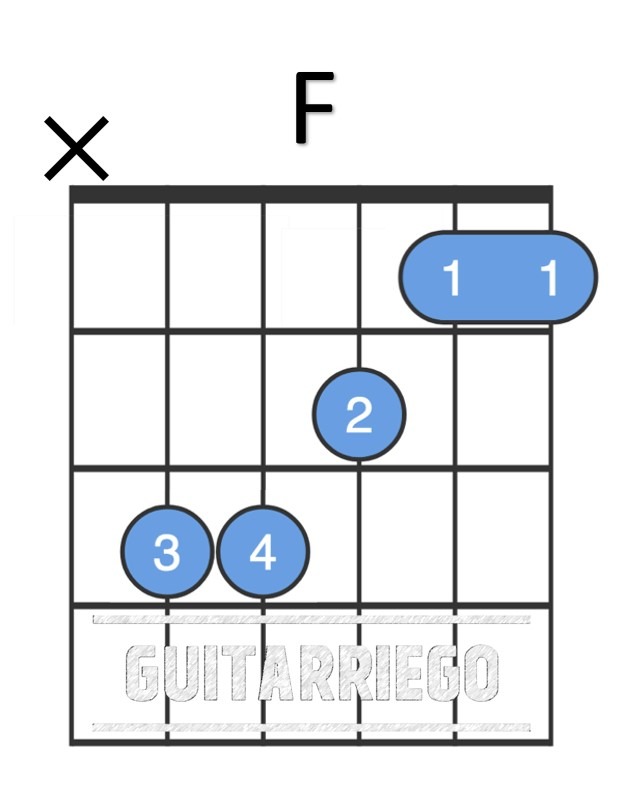
In addition to being easy to play the intermediate F chord, once you master the open chord, it already predisposes the hand position to be able to do the full F chord. Thus, the intermediate chord is already teaching you how to orient your hand and wrist to be able to move to the F chord with a full barre.
The key to mastering the intermediate F chord
An important point here is the correct placement of the thumb when making the F chord. Normally, when we play open chords such as G, A, C and even F, we usually place our thumb above the neck of the guitar so that we rest the palm of the hand on the back of the neck. On the other hand, with the intermediate F chord, the support must be done with the thumb, so that it is pressing in the center of the back of the neck perpendicular to the direction of the strings.
Below you can see the sequence of how the intermediate chord will make you improve your hand position. The first image shows how most guitarists accommodate their hand with open chords. Although technically it is said that it is an incorrect position, the genius of Jimi Hendrix used this hand position. The second image is an intermediate position before reaching the correct position to play the barre F chord, which is the third and last image.
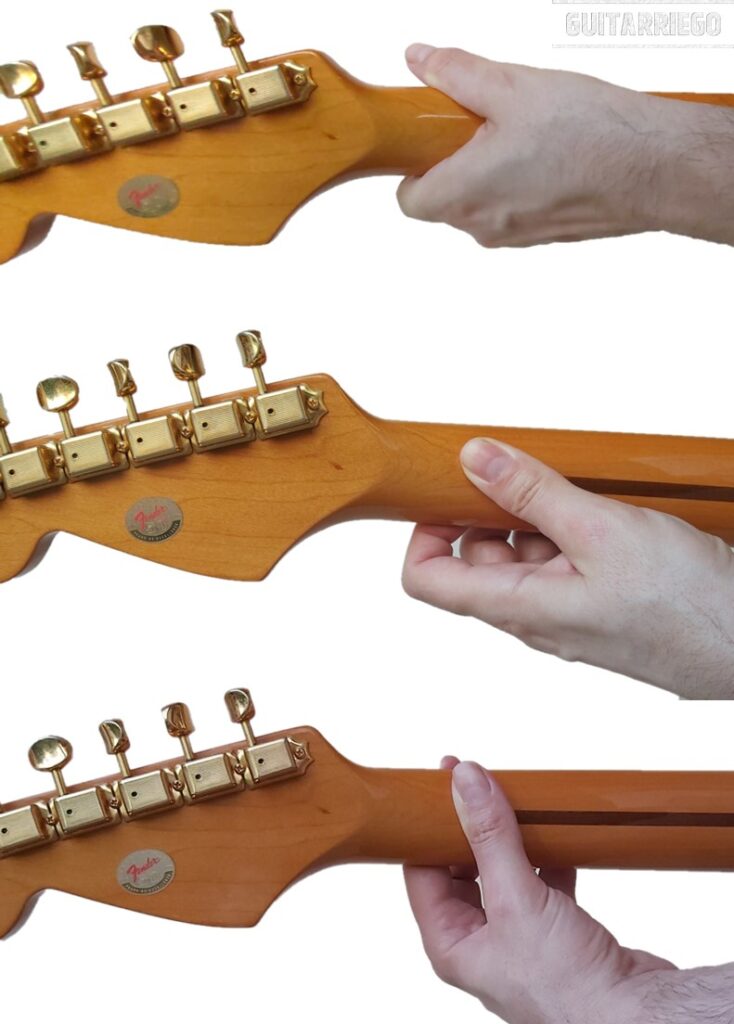
The intermediate chord of F, is nothing more than the F chord with bass in C. That means that the lowest note in the chord is C. The way to write this chord is F/C.
To master the intermediate F chord, do the same exercises that we explained in the easy chord. Chord changes at low speed with metronome.
How to Play the Full Barre F Chord
Once you’ve mastered the intermediate F chord, moving to the full bar chord is one more small step. Simply, stretching your index finger along the entire length of fret 1, making sure that strings 1, 2 and 6 sound good with the full bar.

It is important that the hand is firm but relaxed, the hand should not be tense. Having a tense hand will cause your fingers to press too hard and detune the strings due to excess tension or cause your fingers to touch the adjoining strings causing them to not sound correctly. Also, too much tension will cause your hand to tire faster, and may even hurt itself in the long run. You should always look for the minimum pressure point that the string requires to sound good.
Complementary exercise: If you feel it necessary, you can practice the barre alone. To do this you must assemble the barre with the index finger and pressing with the thumb on the back of the neck –as we teach you in the section of the intermediate F chord-. You must get all the strings to sound correctly, and move through different frets. This will help you to strengthen your index finger while educating your hand to position the wrist and the thumb correctly for the building of the barre.
Difficulties in the process of learning the F chord on guitar
The most common problems learning the different F major chords are:
1) Some string, usually the second or the first, hums and does not sound properly. This is normal until your barre is well exercised and you can press all the strings evenly.
2) When you add the barre, the big, ring and little fingers will move, which may cause you not to press the strings properly or that one of your fingers rubs the string below or above, making to these not sound properly.
Keep in mind that these are common and normal mistakes in the learning process. The important thing is to be consistent in practice. Advance step by step, move on to the next once you have mastered the previous step. Strengthen your fingers with practice and perseverance, especially the index and thumb.
The importance of the structure of the Guitar Full Barre F chord
The full barre F chord structure is a super common structure on the guitar. Thus, the shape of the full barre chord does not belong to a certain note, as in this case F. The first “hidden” example is the E major chord, if you look at it carefully, you will see that it has the same structure as the F chord, only that when moving one fret down, the barre is made by the nut as the F chord.

In this way, by moving this chord structure along the fretboard of the guitar, you will be able to play the major chords of the different notes. Thus, if you play the chord resting the barre on Fret III, you will be playing a G major; by placing the barre on the V fret, you build the A major chord, and so on.
Thus, the F barre chord is the first big step into the world of barre chords. In order to master these barre chords you must learn the names of the musical notes along the guitar fretboard. You may also be interested in the CAGED system to play chords across the entire fretboard.


